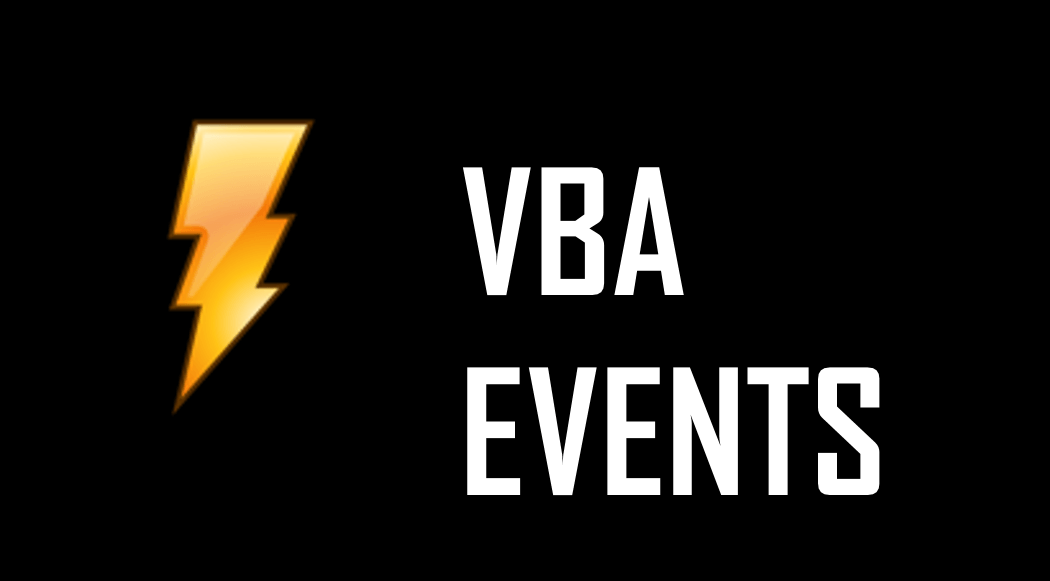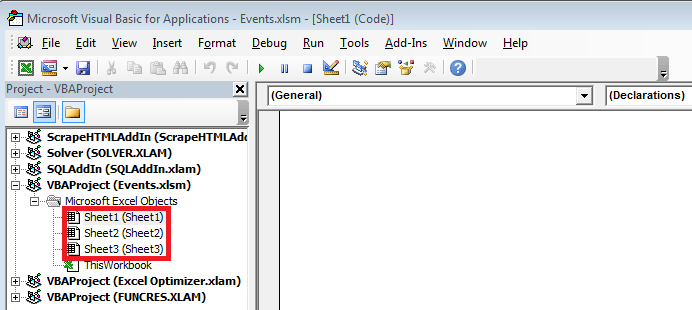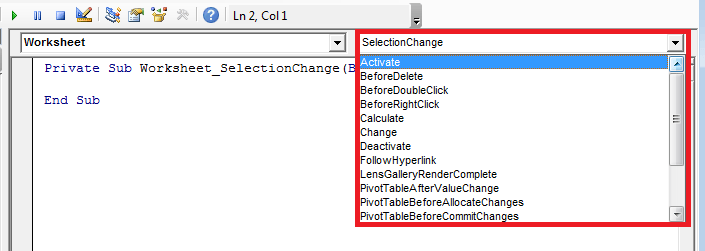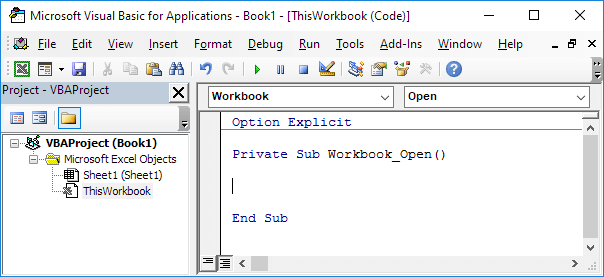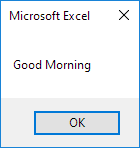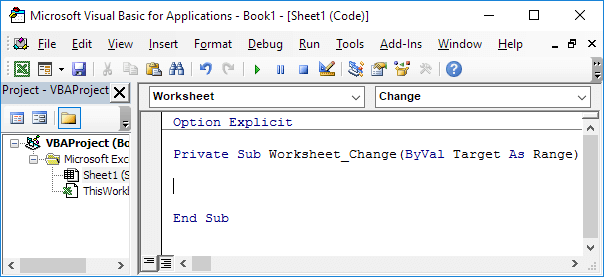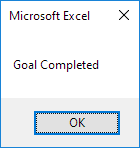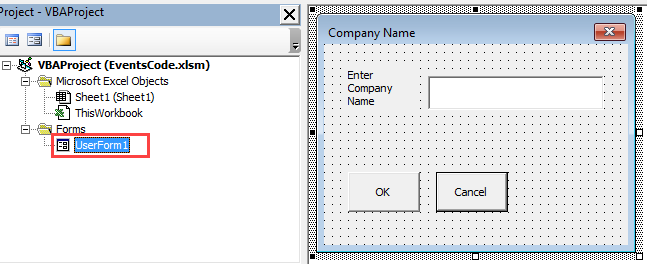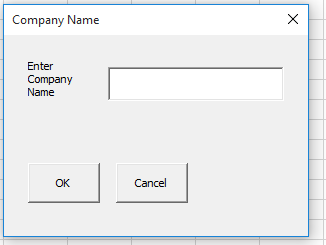Often when working with Excel files we want to introduce certain features which are supposed to be fired in the circumstance of certain events. Say we have a Excel worksheet that is time-sensitive, that needs to be updated based on some web-resource or database. Should we hope that the user will leverage our Refresh button. Fortunately Microsoft introduced Excel Workbook Events – events which are fired in very specific situation in reaction to user interaction. This
Introduction
Excel VBA Events such as the VBA Open Workbook event are very useful in organizing your Workbooks functionality and ease of use. Although VBA events have many advantages, be aware of one significant setback – whenever a VBA Event is fired VBA Code is executed! So? Isn’t that the point? Of course but that has some repercussions – as Excel (and other MS Office Applications) delete the Undo/Redo stack of events once VBA code is executed. This means that whenever a VBA Macro is executed the user will not be able to undo any previous changes to the Workbook using i.e. CTRL+Z.
Therefore be sure to limit your VBA Event handlers to the bare minimum as you may find users annoyed instead of impressed with your Excel GUI.
The VBA Open Workbook and other Workbook events are fired whenever an event in scope of the entire Workbook happens. This can include Activating, Saving, Opening or Closing the Workbook.
Adding Workbook Events
Let’s learn how to add Workbook events:
Select the Workbook module
Select the Workbook module from your Project – VBAProject window as shown below.
Select Workbook from the Object list
To view all available events associated with your Workbook select the Workbook value from the Object list in the Code window. This should automatically include the VBA Open Workbook event into your Workbook module.
Select the desired event from the available list of events
By selecting the Workbook Object from the previous list you will now have access to the available list of events associated with your Workbook. Simply select the desired VBA event from the list and the code will be added automatically.
List of Workbook Events (VBA Open Workbook etc.)
Below is a complete list of VBA Workbook Events available from Excel:
| Event Name | Descriptions |
|---|---|
| ActivateEvent | Workbook is activated |
| AddinInstall | Workbook is installed as an add-in |
| AddinUninstall | Workbook is uninstalled as an add-in |
| AfterSave | Workbook is saved |
| AfterXmlExport | Excel saves or exports data from the workbook to an XML data file |
| AfterXmlImport | An existing XML data connection is refreshed or after new XML data is imported into the workbook |
| BeforeClose | Before the workbook closes. If the workbook has been changed, this event occurs before the user is asked to save changes |
| BeforePrint | Before the workbook (or anything in it) is printed |
| BeforeSave | Before the workbook is saved |
| BeforeXmlExport | Before Excel saves or exports data from the workbook to an XML data file |
| BeforeXmlImport | Before an existing XML data connection is refreshed or before new XML data is imported into the workbook |
| Deactivate | Workbook is deactivated |
| New | New workbook is created |
| NewChart | New chart is created in the workbook |
| NewSheet | New sheet is created in the workbook |
| Open | Workbook is opened |
| PivotTableCloseConnection | After a PivotTable report closes the connection to its data source |
| PivotTableOpenConnection | After a PivotTable report opens the connection to its data source |
| RowsetComplete | The user navigates through the recordset or invokes the rowset action on an OLAP PivotTable |
| SheetActivate | When any sheet is activated. |
| SheetBeforeDoubleClick | When any worksheet is double-clicked, before the default double-click action. |
| SheetBeforeRightClick | When any worksheet is right-clicked, before the default right-click action. |
| SheetCalculate | After any worksheet is recalculated or after any changed data is plotted on a chart |
| SheetChange | When cells in any worksheet are changed by the user or by an external link. |
| SheetDeactivate | When any sheet is deactivated |
| SheetFollowHyperlink | When you click any hyperlink in a workbook |
| SheetPivotTableAfterValueChange | After a cell or range of cells inside a PivotTable are edited or recalculated (for cells that contain formulas) |
| SheetPivotTableBeforeAllocateChanges | Before changes are applied to a PivotTable |
| SheetPivotTableBeforeCommitChanges | Before changes are committed against the OLAP data source for a PivotTable |
| SheetPivotTableBeforeDiscardChanges | Before changes to a PivotTable are discarded |
| SheetPivotTableChangeSync | After changes to a PivotTable |
| SheetPivotTableUpdate | After the sheet of a PivotTable report has been updated |
| SheetSelectionChange | When the selection changes on any worksheet. Does not occur if the selection is on a chart sheet |
| Shutdown | When the workbook host item shuts down |
| Startup | After the workbook is running and all the initialization code in the assembly has been run |
| SyncEvent | When the local copy of a worksheet that is part of a Document Workspace is synchronized with the copy on the server |
| WindowActivate | When any workbook window is activated |
| WindowDeactivate | When any workbook window is deactivated |
| WindowResize | When any workbook window is resized |
Worksheet VBA Events
Adding Worksheet Events
The VBA Open Workbook and other Workbook events are fired whenever an event in scope of the entire Workbook happens. This can include Activating, Saving, Opening or Closing the Workbook.
Adding Workbook Events
Let’s learn how to add Worksheet events:
Select a Worksheet module
Select the Worksheet module from your Project – VBAProject window as shown below. Be sure to select the Worksheet in which you want to add the event handler!:
Select Worksheet from the Object list
To view all available events associated with your Worksheet select the Worksheet value from the Object list in the Code window. This should automatically include the VBA SelectedChange Worksheet event into your Worksheet module.
Select the desired event from the available list of events
By selecting the Worksheet Object from the previous list you will now have access to the available list of events associated with your Worksheet. Simply select the desired VBA event from the list and the code will be added automatically.
List of Worksheet Events
| Event Name | Descriptions |
|---|---|
| Activate | When a workbook, worksheet, chart sheet, or embedded chart is activated. |
| BeforeDelete | |
| BeforeDoubleClick | When a worksheet is double-clicked, before the default double-click action. |
| BeforeRightClick | When a worksheet is right-clicked, before the default right-click action. |
| Calculate | After the worksheet is recalculated, for the Worksheet object. |
| Change | When cells on the worksheet are changed by the user or by an external link. |
| Deactivate | When the chart, worksheet, or workbook is deactivated. |
| FollowHyperlink | When you click any hyperlink on a worksheet. For application- and workbook-level events, see theSheetFollowHyperlink event and SheetFollowHyperlink event. |
| LensGalleryRenderComplete | When a callout gallery’s icons (dynamic & static) have completed rendering. |
| PivotTableAfterValueChange | After a cell or range of cells inside a PivotTable are edited or recalculated (for cells that contain formulas). |
| PivotTableBeforeAllocateChanges | Before changes are applied to a PivotTable. |
| PivotTableBeforeCommitChanges | Before changes are committed against the OLAP data source for a PivotTable. |
| PivotTableBeforeDiscardChanges | Before changes to a PivotTable are discarded. |
| PivotTableChangeSync | After changes to a PivotTable. |
| PivotTableUpdate | After a PivotTable report is updated on a worksheet. |
| SelectionChange | When the selection changes on a worksheet. |
| TableUpdate | After a Query table connected to the Data Model is updated on a worksheet. |
Chart VBA Events
Adding Chart Events
Let’s learn how to add Chart events:
Select a Chart module
Select the Chart module from your Project – VBAProject window as shown below. Be sure to select the Chart to which you want to add the event handler!:
Select Chart from the Object list
To view all available events associated with your Chart select the Chart value from the Object list in the Code window. This should automatically include the VBA Activate Chart event into your Chart module.
Select the desired event from the available list of events
By selecting the Chart Object from the previous list you will now have access to the available list of events associated with your Chaet. Simply select the desired VBA event from the list and the code will be added automatically.
List of Chart Events
| Event Name | Descriptions |
|---|---|
| Activate | chart sheet, or embedded chart is activated. |
| BeforeDoubleClick | when a chart element is double-clicked, before the default double-click action. |
| BeforeRightClick | when a chart element is right-clicked, before the default right-click action. |
| Calculate | after the chart plots new or changed data, for the Chart object. |
| Deactivate | when the chart, worksheet, or workbook is deactivated. |
| MouseDown | when a mouse button is pressed while the pointer is over a chart. |
| MouseMove | when the position of the mouse pointer changes over a chart. |
| MouseUp | when a mouse button is released while the pointer is over a chart. |
| Resize | when the chart is resized. |
| Select | when a chart element is selected. |
| SeriesChange | when the user changes the value of a chart data point by clicking a bar in the chart and dragging the top edge up or down thus changing the value of the data point. |
Use Cases
I decided to list some interesting examples of Workbook VBA events usage:
- Before save notification – if you don’t want to overwrite your current file version you may want to override the BeforeSave Workbook VBA event to add an additional prompt to confirm if you want to overwrite your current file. Code below:
Private Sub Workbook_BeforeSave(ByVal SaveAsUI As Boolean, Cancel As Boolean) Cancel = (MsgBox("Are you sure?", vbYesNo, "Question") = vbNo) End Sub - Refresh all PivotTables and QueryTables on VBA Open Workbook Event – if you want to make sure your Pivot Tables are up to date whenever someone opens your Workbooks add a simple piece of code:
Private Sub Workbook_Open() ActiveWorkbook.RefreshAll End Sub - Prevent Changes to certain Cells – say you want to prompt a user when changing a certain cell value and revert to a default value otherwise. Simply override the VBA Change Event as follows:
Private Sub Worksheet_Change(ByVal Target As Range) If Target = Range("A1") And Target.Value <> 100 Then If MsgBox("Are you sure you want to change this cell?", vbYesNo) = vbNo Then 'Revert Target value Application.EnableEvents = False Target.Value = 100 Application.EnableEvents = True End If End If End Sub
VBA Excel Workbook_Open Event
Excel predefines some popular actions that you would do on different Objects (worksheet, workbook, button, etc), those actions are called Event. For example, activating a worksheet is an Event, closing a workbook is an Event, clicking on a button is an event. Each Object has its own list of Events, Workbook has a list of Events (e.g. close workbook, open workbook), worksheet has a list of Events (e.g. activate worksheet, edit a Cell).
If you perform an Event, say, closing a workbook, your desired code can be triggered. For example, you may want to save a workbook automatically when you close a workbook, or you may want a welcome message box to pop up when a workbook is opened. Event is a Sub Procedure (begin with Private Sub and end with End Sub) and is generated automatically (see in the below section) with a specific name, you can call a Sub Procedure or write your own code within the Event code.
One common use of Workbook_Open Event is that people make application in Excel User Form and they want the Form look like a non-Excel, real Windows application. When user opens the Workbook, a Form pops up and the Excel application (the Excel background) is hidden.
You may ask why people do this instead of doing a real Visual Basic Application. The reason is that using VB.Net application very likely requires installation of .NET Framework but that would require Administration privilege, which could be a problem if you are not an IT administrator at workplace.
To me, I use Workbook_Open Event to apply formatting after I export data from Access to Excel. I cannot pre-format Excel because somehow Access would screw up the pre-formatting.
Example of Excel Workbook_Open Event
1) Press ALT+11 to enter VBE (Visual Basic Editor)
2) Double click on ThisWorkbook > select Workbook > Select Open
3) Insert your code between Private Sub and End Sub. For example, the below code assigns hotkey Crtl+Shift+k to Macro1 when Workbook is Opened
Private Sub Workbook_Open() Application.OnKey "^+k", "Macro1" End Sub
If you want to know more about OnKey Method, click here
Note that Workbook_Open Event can be skipped by holding SHIFT button, but you need to open that workbook from another workbook. Simply put, open workbook A, hold shift, open workbook B
Alternative for Excel Workbook_Open Event using Auto_Open
The below method uses Auto_Open, which is an old approach for auto run Macro before Workbook_Open Event was implemented.
1) ALT+11 to enter VBE (Visual Basic Editor)
2) Insert Module
3) Insert the below code
Sub Auto_Open() End Sub
4) If you already have a Sub Procedure called Macro1, then type
Sub Auto_Open() Macro1 End Sub
If you want to auto run User Form called UserForm1, then type
Sub Auto_Open() UserForm1.Show End Sub
Outbound References
https://msdn.microsoft.com/en-us/library/office/ff194819%28v=office.15%29.aspx
Workbook Open Event | Worksheet Change Event
Events are actions performed by users which trigger Excel VBA to execute code.
Workbook Open Event
Code added to the Workbook Open Event will be executed by Excel VBA when you open the workbook.
1. Open the Visual Basic Editor.
2. Double click on This Workbook in the Project Explorer.
3. Choose Workbook from the left drop-down list. Choose Open from the right drop-down list.
4. Add the following code line to the Workbook Open Event:
MsgBox «Good Morning»
5. Save, close and reopen the Excel file.
Result:
Worksheet Change Event
Code added to the Worksheet Change Event will be executed by Excel VBA when you change a cell on a worksheet.
1. Open the Visual Basic Editor.
2. Double click on a sheet (for example Sheet1) in the Project Explorer.
3. Choose Worksheet from the left drop-down list. Choose Change from the right drop-down list.
Add the following code lines to the Worksheet Change Event:
4. The Worksheet Change Event listens to all changes on Sheet1. We only want Excel VBA to do something if something changes in cell B2. To achieve this, add the following code lines:
If Target.Address = «$B$2» Then
End If
5. We only want Excel VBA to show a MsgBox if the user enters a value greater than 80. To achieve this, add the following code line between If and End If.
If Target.Value > 80 Then MsgBox «Goal Completed»
6. On Sheet1, enter a number greater than 80 into cell B2.
Result:
In this Article
- What are VBA events?
- Types of Events
- Dangers of Using Code in Events
- Disable Events
- Workbook Events Examples (not exhaustive)
- Workbook Open Event
- Workbook New Sheet Event
- Workbook Before Save Event
- Workbook Before Close Event
- Worksheet Event Examples (not exhaustive)
- Worksheet Change Event
- Worksheet Before Double Click Event
- Worksheet Activate Event
- Active X Control Events (not exhaustive)
- Command Button Click Event
- Drop Down (Combo Box) Change Event
- Tick Box (Check Box) Click Event
- UserForm Events (not exhaustive)
- UserForm Activate Event
- Change Event
- Click Event
- Chart Events
- Application Events
- Application.OnTime
- Application.OnKey
What are VBA events?
Events are happening all the time when a user opens an Excel workbook and starts doing various actions such as entering data into cells or moving between sheets
Within the Visual Basic Editor (ALT+F11), sub routines are already set up which can get fired off when the user does something e.g. entering data into a cell. The sub routine does not provide any action code, merely a ‘Sub’ statement and an ‘End Sub’ statement with no code between them. They are effectively dormant so nothing happens until you enter some code.
Here is an example based on the ‘Change’ event in a worksheet:
As a VBA programmer, you can add in code to make certain things happen when the user takes a specific action. This gives you the chance to control the user, and to prevent them taking actions that you do not want them to do and which might damage your workbook. For example, you may want them to save off their own individual copy of the workbook under another name, so that they do not affect the original, which may be being used by a number of users.
If they close the workbook, then they will automatically be prompted to save their changes. However, the workbook has a ‘BeforeClose’ event and you can enter code to prevent the workbook being closed and firing off a ‘Save’ event. You can then add a button to the worksheet itself and put your own ‘Save’ routine onto it. You can also disable the ‘Save’ routine using the ‘BeforeSave’ event
An understanding of how events work is absolutely essential to a VBA programmer.
Types of Events
Workbook Events – these events are fired off based on what the user does with the workbook itself. They include user actions such as opening the workbook, closing the workbook, saving the workbook, adding or deleting sheet
Worksheet Events – these events are fired off by a user taking actions on a specific worksheet. Every worksheet within the workbook has an individual code module, which contains various events specifically for that worksheet (not for all the worksheets). These include user actions such as changing the contents of a cell, double clicking on a cell, or right clicking on a cell.
Active X Control Events – Active X controls can be added to a worksheet using the ‘Insert’ icon on the ‘Developer’ tab in the Excel ribbon. These are often button controls to enable the user to take various actions under control of your code, but they can also be objects such as drop downs. Using Active X controls as opposed to Form controls on the worksheet gives a whole scope for programmability. Active X controls give you far more flexibility from a programming point of view over using form controls in a worksheet.
For example, you could have two drop down controls on your worksheet. You want the available list in the second drop down to be based on what the user chose in the first drop down. Using the ‘Change’ event on the first drop down, you can create code to read what the user has selected and then update the second drop down. You could also de-activate the second drop down until the user has made a selection in the first drop down
UserForm Events – You can insert and design a professional looking form to use as a pop-up. All the controls that you place on your form are Active X controls and they have the same events as the Active X controls that you might place on a worksheet
Chart Events – These events are only related to a chart sheet and not to a chart appearing as part of a worksheet. These events include resizing the chart or selecting the chart.
Application Events – These use the Application object in VBA. Examples would allow code to be fired off when a certain key is pressed or when a certain time is reached. You could program a situation where the workbook is left open 24/7 and it imports data from an external source overnight at a pre-determined time.
Dangers of Using Code in Events
When you write code to do something when the user takes a certain action, you need to bear in mind that your code could be triggering other events, which could put your code into a continuous loop.
For example, suppose that you use the ‘Change’ event on a worksheet so that when the user puts a value into a cell, a calculation based on that cell is placed into the cell immediately to the right of it.
The problem here is that the placing of the calculated value into the cell triggers another ‘Change’ event, which then in turn triggers yet another ‘Change’ event, and so on until your code has run out of columns to use, and throws up an error message.
You need to think carefully when writing the code for the event to ensure that other events will not be triggered inadvertently
Disable Events
You can use code to disable events to get around this problem. What you will need to do is to incorporate code to disable events whilst your event code is running and then re-enable events at the end of the code. Here is an example of how to do it:
Sub DisableEvents()
Application.EnableEvents = False
Application.EnableEvents = True
End Sub
Bear in mind that this disables all events right across the Excel application, so this would also affect other functions within Excel. If you use this for any reason, make sure that events are switched back on afterwards.
Importance of Parameters in Events
Events usually have parameters which you can use to find out more about what the user is doing and the cell location that they are in.
For example, the Worksheet Change event looks like this:
Private Sub Worksheet_Change(ByVal Target As Range)By using the range object, you can find out the cell row/column coordinates that the user is actually in.
Private Sub Worksheet_Change(ByVal Target As Range)
MsgBox Target.Column
MsgBox Target.Row
End Sub
If you only want your code to work on a certain column or row number, then you add a condition that exits the subroutine if the column is not the required one.
Private Sub Worksheet_Change(ByVal Target As Range)
If Target.Column <> 2 Then Exit Sub
End Sub
This gets around the problem of your code triggering multiple events, since it will only work if the user has changed a cell in column 2 (column B)
Workbook Events Examples (not exhaustive)
The workbook events are found under the ‘ThisWorkbook’ object in the VBE Project Explorer. You will need to select ‘Workbook’ on the first drop down on the code window and then the second drop down will show you all the events available
Workbook Open Event
This event is fired off whenever the workbook is opened by a user. You could use it to put a welcome message to a user by capturing their username
Private Sub Workbook_Open()
MsgBox "Welcome " & Application.UserName
End Sub
You could also check their username against a list held on a hidden sheet to see if they are authorised to access the workbook. If they are not an authorised user, then you can display a message and close the workbook so that they cannot use it.
Workbook New Sheet Event
This event is triggered when a user adds a new sheet to the workbook
You could use this code to only allow yourself to add a new sheet, rather than have different users all adding sheets and making a mess of the workbook
Private Sub Workbook_NewSheet(ByVal Sh As Object)
Application.DisplayAlerts = False
If Application.UserName <> "Richard" Then
Sh.Delete
End If
Application.DisplayAlerts = True
End Sub
Note that you need to switch off the alerts as a user warning will appear when the sheet is deleted which allows the user to circumvent your code. Make sure that you turn the alerts back on afterwards!
VBA Coding Made Easy
Stop searching for VBA code online. Learn more about AutoMacro — A VBA Code Builder that allows beginners to code procedures from scratch with minimal coding knowledge and with many time-saving features for all users!
Learn More
Workbook Before Save Event
This event is triggered when the user clicks on the ‘Save’ icon, but before the ‘Save’ actually takes place
As described earlier, you may want to prevent users saving their changes to the original workbook, and force them to create a new version using a button on the worksheet. All that you need to do is to change the ‘Cancel’ parameter to True, and the workbook can never be saved by the conventional method.
Private Sub Workbook_BeforeSave(ByVal SaveAsUI As Boolean, Cancel As Boolean)
Cancel = True
End Sub
Workbook Before Close Event
You can use this event to prevent users closing down the workbook, and again force them to exit through a worksheet button. Again, you set the ‘Cancel’ parameter to ‘True’. The red X in the top right-hand corner of the Excel window no longer works any more.
Private Sub Workbook_BeforeClose(Cancel As Boolean)
Cancel = True
End Sub
Worksheet Event Examples (not exhaustive)
The worksheet events are found under the specific sheet name object in the VBE Project Explorer. You will need to select ‘Worksheet’ on the first drop down on the code window and then the second drop down will show you all the events available
VBA Programming | Code Generator does work for you!
Worksheet Change Event
This event is triggered when a user makes a change to a worksheet, such as entering a new value into a cell
You can use this event to put an additional value or comment in next to the changed cell, but as discussed earlier, you do not want to start setting off a loop of events.
Private Sub Worksheet_Change(ByVal Target As Range)
If Target.Column <> 2 Then Exit Sub
ActiveSheet.Cells(Target.Row, Target.Column + 1). Value = _
ActiveSheet.Cells(Target.Row, Target.Column). Value * 1.1
End Sub
In this example, the code will only work if the value is entered into Column B (column 2). If this is true then it will add 10% to the number and place it into the next available cell
Worksheet Before Double Click Event
This event will fire off code if a user double clicks on a cell. This can be extremely useful for financial reports such as a balance sheet or profit & loss account where numbers are likely to be challenged by managers, especially if the bottom line is negative!
You can use this to provide a drill-down facility, so that when the manager challenges a particular number, all they have to do is double click on the number, and the breakdown appears as part of the report.
This is very impressive from a user’s point of view, and saves them constantly asking ‘why is this number so high?’
You would need to write code to find out the heading / criteria for the number (using the Target object properties) and then filter the tabular data and then copy it into the report.
Worksheet Activate Event
This event occurs when the user moves from one sheet to another. It applies to the new sheet that the user is moving to.
It could be used to ensure that the new sheet is completely calculated before the user starts doing anything on it. It can also be used to only re-calculate that particular sheet without re-calculating the entire workbook. If the workbook is large and has complicated formula in it, then re-calculating one sheet saves a lot of time
Private Sub Worksheet_Activate()
ActiveSheet.Calculate
End Sub
Active X Control Events (not exhaustive)
As discussed earlier, you can add Active X controls directly onto a worksheet. These can be command buttons, drop downs, and list boxes
The Active X events are found under the specific sheet name object (where you added the control) in the VBE Project Explorer. You will need to select the name of the Active X control on the first drop down on the code window and then the second drop down will show you all the events available
Command Button Click Event
When you have put a command button onto a spreadsheet, you will want it to take some action. You do this by putting code on the Click event.
You can easily put an ‘Are you sure message?’ on this so that a check is made before your code runs
Private Sub CommandButton1_Click ()
Dim ButtonRet As Variant
ButtonRet = MsgBox("Are you sure that you want to do this?", vbQuestion Or vbYesNo)
If ButtonRet = vbNo Then Exit Sub
End Sub
AutoMacro | Ultimate VBA Add-in | Click for Free Trial!
Drop Down (Combo Box) Change Event
An Active X drop down has a change event, so that if a user selects a particular item from the drop-down list, you can capture their choice using this event and then write code to adapt other parts of the sheet or workbook accordingly.
Private Sub ComboBox1_Change ()
MsgBox "You selected " & ComboBox1.Text
End Sub
Tick Box (Check Box) Click Event
You can add a tick or check box to a worksheet so as to provide option choices for the user. You can use the click event on it to see if the user has changed anything on this. The values returned are True or False according to whether it has been ticked or not.
Private Sub CheckBox1_Click ()
MsgBox CheckBox1.Value
End Sub
UserForm Events (not exhaustive)
Excel provides the ability for you to design your own forms. These can be very useful to use as pop-ups to collect information or to provide multiple choices to the user. They use Active X controls as described previously and have exactly the same events, although the events depend very much on the type of control.
Here is an example of a simple form:
When it is displayed this is what it looks like on screen
You would use events on the form to do things like enter a default company name when the form is opened, to check the company name input agrees to one already in the spreadsheet and has not been mis-spelt, and to add code to the click events on the ‘OK’ and ‘Cancel’ buttons
The code and events behind the form can be viewed by double clicking anywhere on the form
The first drop down gives access to all the controls on the form. The second drop down will give access to the events
AutoMacro | Ultimate VBA Add-in | Click for Free Trial!
UserForm Activate Event
This event is triggered when the form is activated, normally when it is displayed. This event can be used to set up default values e.g. a default company name in the company name text box
Private Sub UserForm_Activate()
TextBox1.Text = "My Company Name"
End Sub
Change Event
Most of the controls on the form have a change event, but in this example, the company name text box can use the event to put a restriction on the length of the company name being entered
Private Sub TextBox1_Change ()
If Len (TextBox1.Text) > 20 Then
MsgBox "The name is restricted to 20 characters", vbCritical
TextBox1.Text = ""
End If
End Sub
Click Event
You can use this event to take action from the user clicking on controls on the form, or even the form itself
On this form there is an ‘OK’ button, and having collected a company name, we would want to place it in a cell on the spreadsheet for future reference
Private Sub CommandButton1_Click ()
ActiveSheet.Range("A1"). Value = TextBox1.Text
Me.Hide
End Sub
This code acts when the user clicks the ‘OK’ button. It puts the value in the company name input box into cell A1 on the active sheet and then hides the form so that user control is returned back to the worksheet.
Chart Events
Chart events only work on charts that are on a separate chart sheet, and not on a chart that is incorporated into a standard worksheet
Chart events are somewhat limited and cannot be used on a worksheet where you might well have multiple charts. Also, users do not necessarily want to switch from a worksheet containing numbers to a chart sheet – there is no immediate visual impact here
The most useful event would be to find out the component of a chart that a user has clicked on e.g. a segment in a pie chart, or a bar in a bar chart, but this is not an event available on the standard range of events.
This problem can be solved by using a class module to add a ‘Mouse Down’ event which will return details of the chart component that the user has clicked on. This is used on a chart within a worksheet.
This involves some very complicated coding, but the results are spectacular. You can create drill downs e.g. the user clicks on a pie chart segment and instantly that chart is hidden and a second chart appears in its place showing a pie chart of detail for the original segment, or you could produce the tabular data supporting that segment of the pie chart.
AutoMacro | Ultimate VBA Add-in | Click for Free Trial!
Application Events
You can use the Application object in VBA to fire off code according to a particular event
Application.OnTime
This can enable you to fire off a piece of code at regular intervals for as long as the workbook is loaded into Excel. You may want to auto-save your workbook to a different folder every 10 minutes, or leave the worksheet running overnight so as to bring in the latest data from an external source.
In this example, a sub routine is entered into a module. It displays a message box to every 5 minutes, although this could easily be another coded procedure. At the same time, it resets the timer to the current time plus 5 more minutes.
Every time it runs, the timer resets to run the same sub routine in another 5 minutes time.
Sub TestOnTime()
MsgBox "Testing OnTime"
Application.OnTime (Now () + TimeValue("00:05:00")), "TestOnTime"
End Sub
Application.OnKey
This function enables you to design your own hot keys. You can make any key combination call a sub routine of your creation.
In this example the letter ‘a’ is redirected so that instead of placing an ‘a’ in a cell, it will display a message box. This code needs to be placed in an inserted module.
Sub TestKeyPress()
Application.OnKey "a", "TestKeyPress"
End Sub
Sub TestKeyPress()
MsgBox "You pressed 'a'"
End Sub
You run the sub routine ‘TestKeyPress’ first of all. You only need to run this once. It tells Excel that every time the letter ‘a’ is pressed it will call the sub routine ‘TestKeyPress’. The sub routine ‘TestKeyPress’ just displays a message box to tell you that you pressed key ‘a’. It could of course load a form or do all sorts of other things.
You can use any key combination that you can use with the ‘SendKeys’ function
To cancel this functionality, you run the ‘OnKey’ statement without the ‘Procedure’ parameter.
Sub CancelOnKey()
Application.OnKey "a"
End Sub
Everything is now back to normal.
Here are some commonly used workbook events.
5 FREE EXCEL TEMPLATES
Plus Get 30% off any Purchase in the Simple Sheets Catalogue!
| Event | Discription |
|---|---|
| ActivateEvent | Occurs when the workbook is activated. |
| BeforeClose | Occurs before the workbook closes. If the workbook has been changed, this event occurs before the user is asked to save changes. |
| BeforePrint | Occurs before the workbook (or anything in it) is printed. |
| BeforeSave | Occurs before the workbook is saved. |
| Deactivate | Occurs when the workbook is deactivated. |
| New | Occurs when a new workbook is created. |
| NewChart | Occurs when a new chart is created in the workbook. |
| NewSheet | Occurs when a new sheet is created in the workbook. |
| Open | Occurs when the workbook is opened. |
| SheetActivate | Occurs when any sheet is activated. |
| SheetChange | Occurs when cells in any worksheet are changed by the user or by an external link. |
| SheetDeactivate | Occurs when any sheet is deactivated. |
| SheetSelectionChange | Occurs when the selection changes on any worksheet. Does not occur if the selection is on a chart sheet. |
| WindowActivate | Occurs when any workbook window is activated. |
| WindowDeactivate | Occurs when any workbook window is deactivated. |
| WindowResize | Occurs when any workbook window is resized. |
Code for workbook events are saved in the ThisWorkbook module.
At the top of the code window change General to Workbook in the first drop down menu.
From the second drop down menu at the top of the code window, select which event you want to write a procedure for.
5 FREE EXCEL TEMPLATES
Plus Get 30% off any Purchase in the Simple Sheets Catalogue!
Example Workbook Event Procedures
The examples below are intended to illustrate the workings of each event rather than to provide commercially useful procedures.
Workbook Open Event
This procedure shows a welcome message in the status bar and window caption. It also presents the user with a welcome message on opening the workbook.
5 FREE EXCEL TEMPLATES
Plus Get 30% off any Purchase in the Simple Sheets Catalogue!
Private Sub Workbook_Open()
Dim UserName As String
UserName = Application.UserName
'Display welcome message on open
MsgBox "Hi There " & UserName & ", the time and date is is " & Now
' Display message in status bar and window caption
Select Case Time
Case Is < 0.5
With Application
.StatusBar = "Good Morning " & UserName _
& ". You opened this file at " & Time
.Caption = "Good Morning " & UserName _
& ". You opened this file at " & Time
End With
Case 0.5 To 0.75
With Application
.StatusBar = "Good Afternoon " & UserName _
& ". You opened this file at " & Time
.Caption = "Good Afternoon " & UserName _
& ". You opened this file at " & Time
End With
Case Is > 0.75
With Application
.StatusBar = "Good Evening " & UserName _
& ". You opened this file at " & Time
.Caption = "Good Evening " & UserName _
& ". You opened this file at " & Time
End With
End Select
'If weekday is Monday display XYZ report reminder
If Weekday(Date) = vbMonday Then _
MsgBox "It's Monday again, you need to file the XYZ Report"
End Sub
New Sheet Event
The New Sheet event creates an argument called Sh. Sh represents the worksheet that has been created. In the example code below we use Sh to name the new sheet.
Sh.Name = SheetName
This example procedure asks the user to name the sheet when it is created. The user input is stored in a variable called SheetName. The date and time the sheet is created is displayed in cell A1.
Private Sub Workbook_NewSheet(ByVal Sh As Object)
Dim SheetName As String
Dim UserName As String
UserName = Application.UserName
SheetName = _
InputBox("You are adding a new sheet. What would you like to call it?")
Sh.Name = SheetName
Range("A1") = "Sheet Created by " & UserName & " on " & Now
End Sub
Sheet Activate Event
5 FREE EXCEL TEMPLATES
Plus Get 30% off any Purchase in the Simple Sheets Catalogue!
The Sheet Activate event also creates an argument called Sh which represents this worksheet that has just been activated. This procedure displays a welcome message when any sheet is activated.
Private Sub Workbook_SheetActivate(ByVal Sh As Object) MsgBox "Welcome to worksheet: " & Sh.Name End Sub
After Save Event
This procedure displays a message confirming the file name and path of the workbook after it has been saved.
Private Sub Workbook_AfterSave(ByVal Success As Boolean) Dim ThisWorkBookName As String Dim ThisWorkBookLocation As String ThisWorkBookName = ActiveWorkbook.Name ThisWorkBookLocation = ActiveWorkbook.Path MsgBox "You just saved " & ThisWorkBookName & " to " & ThisWorkBookLocation End Sub
Before Close Event
The Before Close event creates a Cancel argument which if set to True will prevent the file being closed. In this example the procedure will only let the user close the file if it is home time.
Private Sub Workbook_BeforeClose(Cancel As Boolean) If Time < "18:00" Then MsgBox "It's not time to go home yet. Carry on working." Cancel = True End If End Sub
Before Print Event
The Before Print event has an argument called Cancel which can used to cancel the print. The procedure below requires the user to enter a password before printing. They get three attempts: everytime they get the password wrong the Cancel argument is set to True.
The procedure also hides column B and C before printing and then calls a separate procedure to unide them (the UnhideColumnsAfterPrint procedure would be stored in a normal module).
5 FREE EXCEL TEMPLATES
Plus Get 30% off any Purchase in the Simple Sheets Catalogue!
Private Sub Workbook_BeforePrint(Cancel As Boolean)
Dim Password As String
Dim x As Integer
'Ask for password before printing (3 attempts)
For x = 1 To 3
Password = InputBox("Please enter password to print")
If Password <> "1234" Then
Cancel = True
MsgBox "Sorry that password is not recognised. You have " _
& 3 - x & " attempts remaining"
Else: Exit For
End If
Next x
'Hide columns B and C before printing
Worksheets("Printing With Hidden Columns").Range("B:C")._
EntireColumn.Hidden = True
'Run the UnhideColumnsAfterPrint procedure one second after the event
Application.OnTime EarliestTime:=Now + TimeValue("0:00:01"), Procedure:="UnhideColumnsAfterPrint"
End Sub
Window Resize Event
The Window Resize event has an argument called Wn which represents the workbook’s window. The example procedure maximises the window whenever the user resizes it.
Private Sub Workbook_WindowResize(ByVal Wn As Window) Wn.Caption = "STOP TRYING TO RESIZE ME!!!!!" Wn.WindowState = xlMaximized End Sub
5 FREE EXCEL TEMPLATES
Plus Get 30% off any Purchase in the Simple Sheets Catalogue!
Worksheet Events
Here are some commonly used worksheet events.
| Event | Description |
|---|---|
| ActivateEvent | Occurs when the worksheet is activated. |
| BeforeDoubleClick | Occurs when the worksheet is double-clicked, before the default double-click action. |
| BeforeRightClick | Occurs when the worksheet is right-clicked, before the default right-click action. |
| Calculate | Occurs after the worksheet is recalculated. |
| Change | Occurs when something changes in the Worksheet cells. |
| Deactivate | Occurs when the worksheet loses focus. |
| FollowHyperlink | Occurs when you click any hyperlink on a worksheet. |
| PivotTableUpdate | Occurs after a PivotTable report is updated on a worksheet. |
| SelectionChange | Occurs when the selection changes on a worksheet. |
Worksheet events are placed in the relevant worksheet module.
At the top of the code window change General to Worksheet in the first drop down menu.
From the second drop down menu at the top of the code window, select which event you want to write a procedure for.
Worksheet Change Event Examples
Automatically Save Workbook if Cell’s Value Change
This procedure automatically saves the workbook if any cell in the specified range changes. The If’s condition uses the Intersect method. Intersect, as it name suggests returns the intersecting range of cells that result when two or more ranges overlap. If no cells overlap intersect will return nothing.
5 FREE EXCEL TEMPLATES
Plus Get 30% off any Purchase in the Simple Sheets Catalogue!
Intersect(FirstRange, SecondRange etc)
The procedure is automatically run with the Worksheet Change event. Target is the range that has been changed. The Target range is automatically returned by the Worksheet Change event.
Private Sub Worksheet_Change(ByVal Target As Range)
If Intersect(Target, Range("A1:D10")) Is Nothing Then
Exit Sub
Else: ThisWorkbook.Save
End If
End Sub
This version will save the workbook if any cell is changed.
Private Sub Worksheet_Change(ByVal Target As Range)
If Intersect(Target, ActiveSheet.UsedRange) Is Nothing Then
Exit Sub
Else: ThisWorkbook.Save
End If
End Sub
Automatically Add Comments When Cell’s Value Changes
In this example the Worksheet change event triggers a procedure that automatically adds a comment to a cell. The comment includes the date and time of the cell entry, the value entered in the cell and the username of the person who added the enty.
Private Sub Worksheet_Change(ByVal Target As Range)
Dim MyCell As Range
Dim Username As String
Username = Application.Username
'If cell's content is deleted, clear comments
For Each MyCell In Target
If MyCell.Value = "" Then
Target.ClearComments
Exit Sub
End If
Next MyCell
For Each MyCell In Target
'If cell doesn't have any comments add comment...
If MyCell.Comment Is Nothing Then
'...displaying current data and time, cell's value and username
MyCell.AddComment Now & " - " & MyCell.Value & " - " & Username
'If cell already has comment add new text to existing comment, _
do not overwrite.
Else
MyCell.Comment.Text _
Text:=vbNewLine & Now & " - " & MyCell.Value & " - " & Username, _
Start:=Len(Target.Comment.Text) + 1, _
Overwrite:=False
End If
'Autosize comments
MyCell.Comment.Shape.TextFrame.AutoSize = True
Next MyCell
End Sub
Validate Data on Entry
In this example the Worksheet Change event checks to see that user has entered a numeric value in the range SalesCells. If the value is not numeric a warning message is displayed and the value is deleted.
Private Sub Worksheet_Change(ByVal Target As Range)
Dim rg As Range
Dim SalesCells As Range
Set SalesCells = Range("B4:G13")
'If the cell change is outside the SalesCells range exit procedure
If Intersect(Target, SalesCells) Is Nothing Then Exit Sub
For Each rg In Intersect(Target, SalesCells)
'If cell entry is not numeric delete entry and show message
If Not IsNumeric(rg) Then
MsgBox "You must enter a numeric value in this cell"
Target.ClearContents
Target.Activate
End If
Next rg
End Sub
Selection Change Event
In this example, the active cell’s column and row are formatted with a grey background. The formatting occurs on selection change.
5 FREE EXCEL TEMPLATES
Plus Get 30% off any Purchase in the Simple Sheets Catalogue!
Private Sub Worksheet_SelectionChange(ByVal Target As Range)
With Cells
.Interior.Color = xlNone
.Font.Color = vbBlack
End With
With ActiveCell
With .EntireColumn
.Interior.Color = rgbDarkGrey
.Font.Color = vbWhite
End With
With .EntireRow
.Interior.Color = rgbDarkGrey
.Font.Color = vbWhite
End With
End With
End Sub
Before Delete Event
This procedure prevents deletion of a sheet by temporarily protecting the workbook.
Private Sub Worksheet_BeforeDelete() ThisWorkbook.Protect Application.OnTime EarliestTime:=Now, Procedure:="UnProtectBook" End Sub
5 FREE EXCEL TEMPLATES
Plus Get 30% off any Purchase in the Simple Sheets Catalogue!
OnKey Events
Use the OnKey method to assign shortcut keys to your macros.
Application.OnKey(Key, Procedure)
OnKey Parameters
| Name | Required/Optional | Data Type | Description |
|---|---|---|---|
| Key | Required | String | A string indicating the key to be pressed. |
| Procedure | Optional | Variant | The name of the procedure to be run. If Procedure is «» (empty text), nothing happens when Key is pressed. If Procedure is omitted, Key reverts to its normal result in Microsoft Excel. |
Refer to specific keys using the codes shown below.
| Key | Code |
|---|---|
| BACKSPACE | {BACKSPACE} or {BS} |
| BREAK | {BREAK} |
| CAPS LOCK | {CAPSLOCK} |
| CLEAR | {CLEAR} |
| DELETE or DEL | {DELETE} or {DEL} |
| DOWN ARROW | {DOWN} |
| END | {END} |
| ENTER (numeric keypad) | {ENTER} |
| ENTER | ~ (tilde) |
| ESC | {ESCAPE} or {ESC} |
| HELP | {HELP} |
| HOME | {HOME} |
| INS | {INSERT} |
| LEFT ARROW | {LEFT} |
| NUM LOCK | {NUMLOCK} |
| PAGE DOWN | {PGDN} |
| PAGE UP | {PGUP} |
| RETURN | {RETURN} |
| RIGHT ARROW | {RIGHT} |
| SCROLL LOCK | {SCROLLLOCK} |
| TAB | {TAB} |
| UP ARROW | {UP} |
| F1 through F15 | {F1} through {F15} |
| Combine with | Precede the key code by |
|---|---|
| SHIFT | + (plus sign) |
| CTRL | ^ (caret) |
| ALT | % (percent sign) |
Assign a Custom Keystroke
To assign the shortcut keys automatically when the workbook opens, place the OnKey statements in the ThisWorkbook module in the Workbook Open event procedure.
Private Sub Workbook_Open()
'Setup OnKeys
Application.OnKey "+{F1}", "SHIFTF1"
End Sub
The procedure the shortcut key calls can be placed in a normal module.
Sub SHIFTF1() Dim User As String User = Application.Username ActiveCell = "Created by " & User & " on " & Now End Sub
Please note that the OnKey assignment applies to all open workbooks.
Unassign a Custom Keystroke
5 FREE EXCEL TEMPLATES
Plus Get 30% off any Purchase in the Simple Sheets Catalogue!
To unassign a custom keystoke, omit the Procedure parameter in the OnKey statement. Place this code in the ThisWorkbook module using the Before Close event procedure.
Private Sub Workbook_BeforeClose(Cancel As Boolean)
'UnAssign OnKeys
Application.OnKey "+{F1}"
End Sub
Disable Built In Excel Keystokes
If you want to disable built in keystokes return an empty text string in the Procedure argument. The following OnKey statement disables ALT F4 which would normally close Excel.
Application.OnKey "%{F4}", ""

